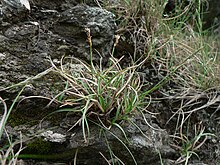
Carex is a vast genus of over 2,000 species of grass-like plants in the family Cyperaceae, commonly known as sedges. Other members of the family Cyperaceae are also called sedges, however those of genus Carex may be called true sedges, and it is the most species-rich genus in the family. The study of Carex is known as caricology.

Dulichium is a monotypic genus of sedge containing the single species Dulichium arundinaceum, which is known by the common name threeway sedge. This is an aquatic or semi-aquatic plant of the lakes, streams, and ponds of the United States and Canada. It has a wide distribution across the two countries, though noticeably absent from the Dakotas and from the Southwestern Deserts.
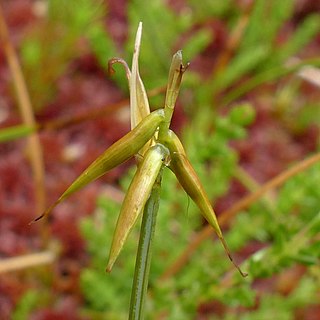
Carex pauciflora, the few-flowered sedge, is a perennial species of sedge in the family Cyperaceae native to bogs and fens in cool temperate, subarctic, and mountainous regions of the Northern Hemisphere. The specific epithet pauciflora refers to the Latin term for 'few flowered'.
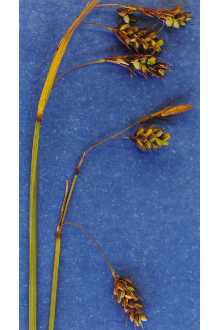
Carex magellanica subsp. irrigua is a perennial species of plants in the family Cyperaceae native to Holarctic wetlands. Common names include poor sedge, bog sedge and boreal bog sedge.

Carex nebrascensis is a species of sedge known as Nebraska sedge.
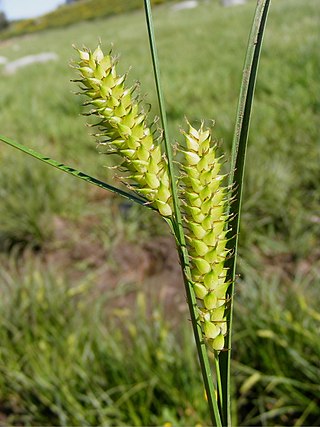
Carex vesicaria is an essentially Holarctic species of sedge known as bladder sedge, inflated sedge, and blister sedge. It has been used to insulate footwear in Norway and among the Sami people, and for basketry in North America.

Carex bigelowii is a species of sedge known by the common names Bigelow's sedge, Gwanmo sedge, and stiff sedge. It has an Arctic–alpine distribution in Eurasia and North America, and grows up to 50 centimetres (20 in) tall in a variety of habitats.

Eriophorum scheuchzeri is a species of flowering plant in the sedge family known by the common names Scheuchzer's cottongrass and white cottongrass. It has an arctic circumpolar and circumboreal distribution in the Northern Hemisphere. It can be found in Alaska, across Canada, in the Arctic islands, Greenland, Iceland, and across Eurasia. Disjunct occurrences exist in the Rocky Mountains, in the high mountains of southern Europe and on Mount Daisetsu in Japan and some other Asian mountains.

Dryas integrifolia is a species of flowering plant in the rose family known by the common names arctic avens, entireleaf mountain-avens, white mountain-avens, northern white mountain avens, and mountain avens. It is native to northern parts of North America, where it occurs from Alaska across Canada to Greenland. It is a common species of the Arctic and it is probably the most common flowering plant on some of the western Arctic islands.

Sandy iris, or sand iris, is a species in the genus Iris; it is also in the subgenus of Iris and in the Psammiris section. It is a rhizomatous perennial, from Central Europe, found in Hungary, Austria, Romania, Czech Republic and Ukraine. It has grass-like leaves, a short stem and pale yellow flowers. It has had a mixed origin and was once Iris humilis subsp. arenaria, a subspecies of Iris humilis, until it was reclassified as a separate species. But many sources still state that it is either a synonym or subspecies of Iris humilis. It is cultivated as an ornamental plant in temperate regions.

Carex viridula, known as little green sedge, green sedge, or greenish sedge, is a small flowering plant native to North America, Europe, Asia, and Morocco.
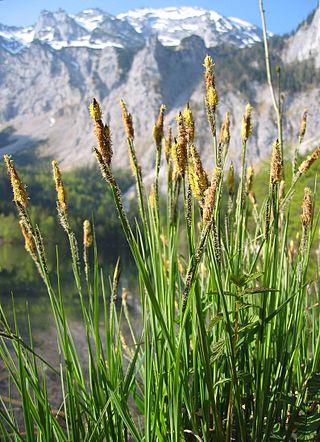
Carex elata, is a species of tussock-forming, grass-like plant in the Cyperaceae family. It is native to all of Europe, the Atlas Mountains of Africa, Turkey, Iran and Central Asia.

Carex curvula, the Alpine sedge, is a species of flowering plant in the genus Carex, native to the Pyrenees, the Alps, the Carpathians, and the mountains of the Balkans. It has gone extinct in Germany. It propagates almost exclusively clonally, with some of its clonal colonies estimated to be 2,000 years old.
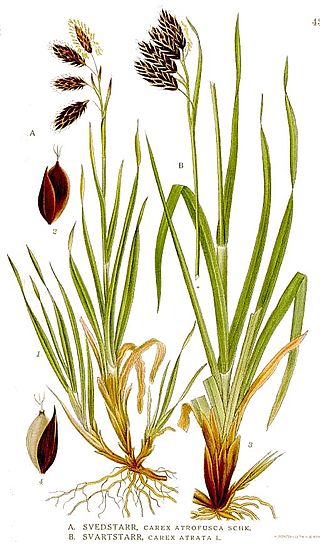
Carex atrata, called black alpine sedge, is a widespread species of flowering plant in the genus Carex, native to Greenland, Iceland, and most of Europe, plus scattered locations across temperate Asia, including Anatolia, Siberia and the Himalaya, as far as Taiwan and Japan. Its chromosome number is 2n=52, with some variants reported, e.g. n2=54 for Greenland material.
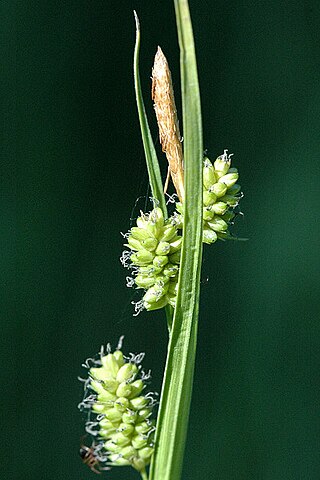
Carex demissa is a species of sedge, native to Iceland, Macaronesia, all of Europe, and western Asia to the Himalayas and possibly Greenland. It has been introduced to eastern Canada, New Jersey, and Tasmania. It is a member of the Carex flava species complex.

Carex tenax, the wire sedge, is a species of flowering plant in the family Cyperaceae, native to Texas and the southeastern United States.
Carex catharinensis is a tussock-forming species of perennial sedge in the family Cyperaceae. It is native to parts of eastern parts of South America.
Carex krauseorum, commonly known as Krause's sedge, is a tussock-forming species of perennial sedge in the family Cyperaceae. It is native to subarctic areas of Greenland, Alaska, northern Canada and Russia.

Carex uruguensis is a tussock-forming species of perennial sedge in the family Cyperaceae. It is native to parts of South America.
Carex cephalotes, also known as wire-head sedge, is a tussock-forming species of perennial sedge in the family Cyperaceae. It is native to south eastern Australia and New Zealand.
